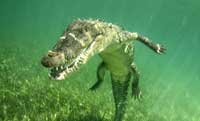It lives from freshwater to saltwater, from US Florida, many Caribbean islands, Central America to Venezuela and Peru. American crocodile lives around 60 years, reaches 4 m of length and 200 kg of weight, although there are reports of 7 m individuals in South America. Its abundance has presumably increased in Jardines de la Reina due to protection. American crocodile is considered Vulnerable by IUCN.
Marine turtles (hawksbill turtle (Eretmochelys imbricata), green turtle (Chelonia mydas), loggerhead turtle (Caretta caretta), leatherback turtle (Dermochelys coriacea):

All these species have seen depleting their population due to over-harvesting to the point that hawksbill and leatherback are considered Critically Endangered and green and loggerhead are considered Endangered by IUCN. The four species of marine turtles occur in Jardines de la Reina, though hawksbill and green are the most common ones, primarily the hawksbill. Jardines de la Reina is the most important nesting are for hawksbill in Cuban waters with 65 % of the reported nationwide. It is known that most of hawksbill turtles spend most of their life cycle in Cuban waters. Hawksbills nest year around, mainly from September to January with the high rate between October and December, later than in other Western Atlantic areas.
Hawksbills prefer to nest in the vegetated zone closest to shoreline. Green turtles use Jardines de la Reina as reproductive and feeding grounds but also as migratory corridors. Green turtles of Jardines de la Reina are strongly connected with Grand Cayman population.
Iguana (Cyclura nubila nubila):

It is the largest terrestrial reptile of Cuba and an endemic subspecies. Iguana is found in the coastal areas of most of the Cuban islands though its populations have decreased and is considered Vulnerable by IUCN. It is considered a keystone species because accelerate germination rate of seeds, provide nutrients to the soil through feces and disperse seeds in its habitats. Iguana is very vulnerable before hurricanes and drought.



